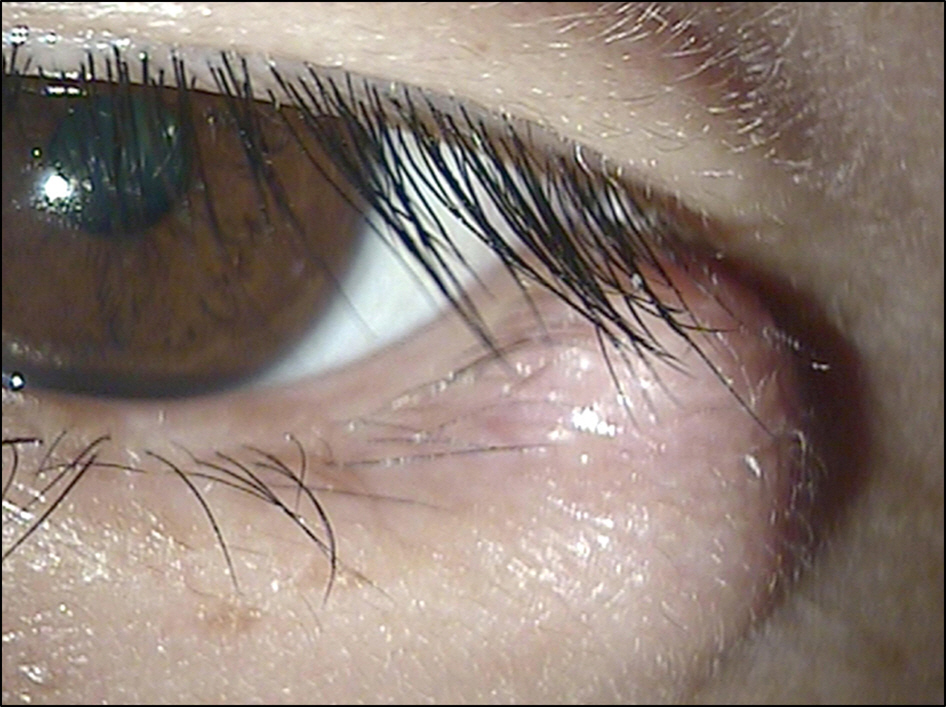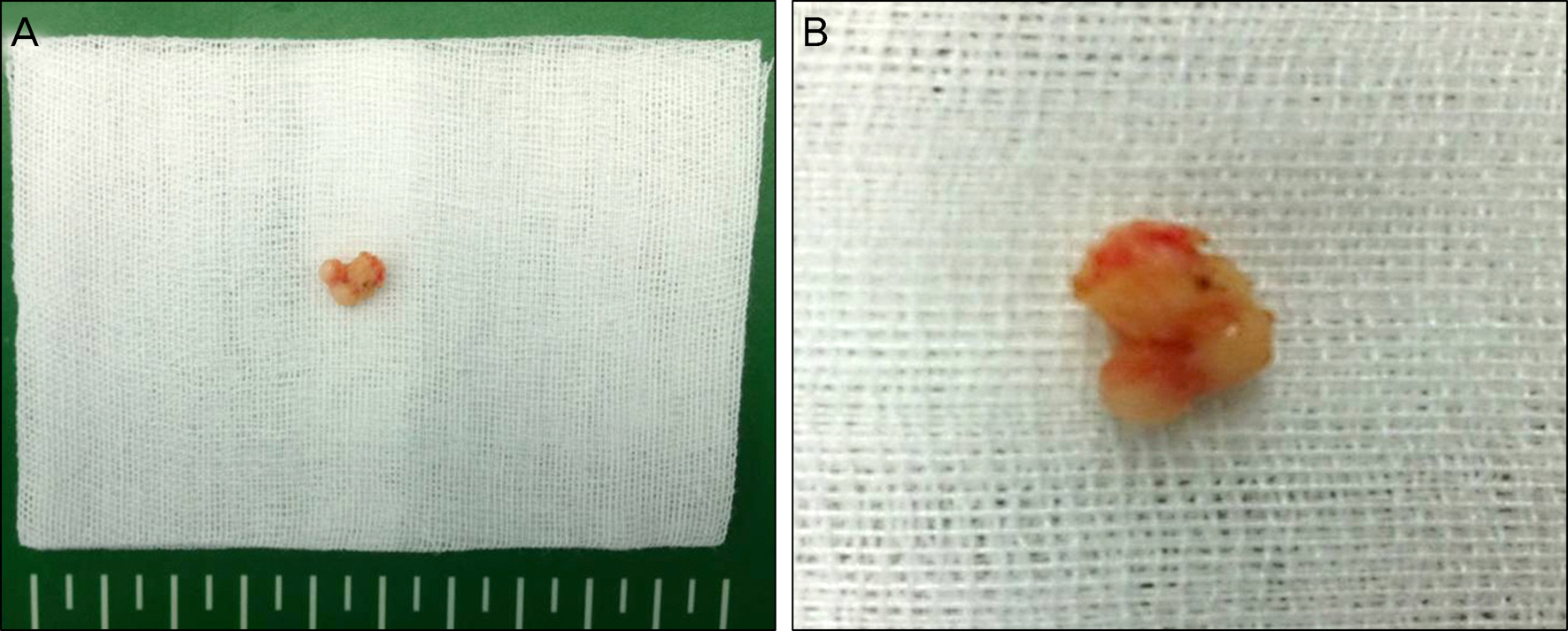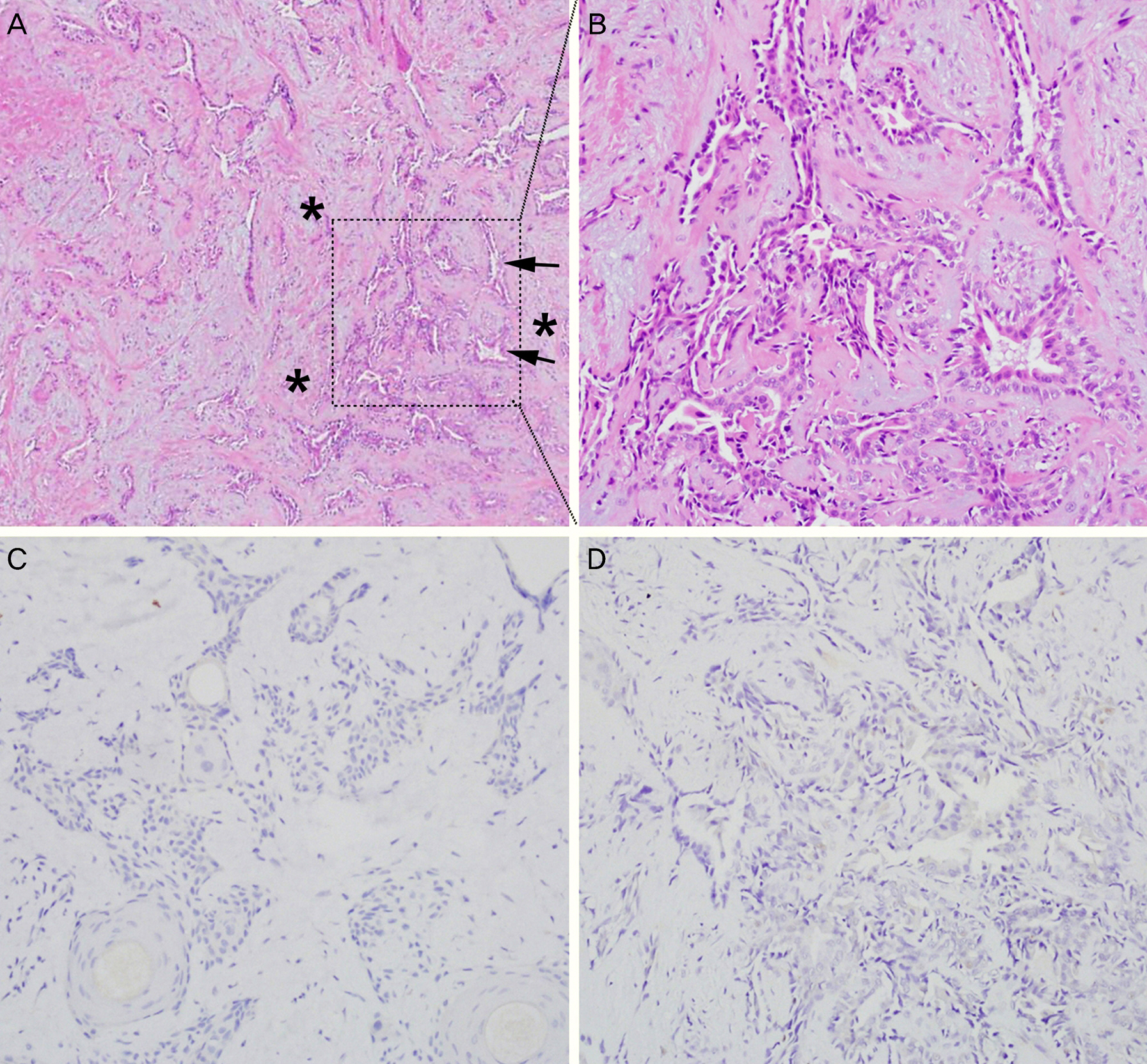J Korean Ophthalmol Soc.
2013 Oct;54(10):1594-1598.
A Case of Pleomorphic Adenoma Arising in the Ectopic Lacrimal Gland of the Lower Eyelid
- Affiliations
-
- 1Department of Ophthalmology, Chonnam National University Medical School, Gwangju, Korea. kcyoon@jnu.ac.kr
Abstract
- PURPOSE
To report a case of pleomorphic adenoma arising in the ectopic lacrimal gland of the lower eyelid.
CASE SUMMARY
A 36-year-old male presented with a gradually increasing mass in the left lower eyelid that had been growing for one year. A hard, non-tender, subcutaneous mass was palpated on the lateral one-third of the left lower eyelid, and there were no clinically specific signs. Orbital computed tomography demonstrated a well-demarcated 1 x 0.7 x 0.7-cm-sized mass with heterogeneous enhancement, and complete surgical resection was performed. The mass was non-adjacent to the conjunctiva and inferior tarsal plate. Histological examination showed glandular elements embedded in a myxoid stroma. The mass was diagnosed as pleomorphic adenoma arising in the ectopic lacrimal gland. At the postoperative 6-month follow-up, there was no recurrence or abnormal finding at the operation site.
CONCLUSIONS
Pleomorphic adenoma arising in the ectopic lacrimal gland should be considered as a differential diagnosis of eyelid masses.
MeSH Terms
Figure
Reference
-
References
1. Shields JA, Blackwell B, Augsburber JJ, Flanagan JC. Classification and incidence of space-occupying lesions of the orbit. A survey of 645 biopsies. Arch Ophthalmol. 1984; 102:1606–11.2. Auran J, Jakobiec FA, Krebs W. Benign mixed tumor of the palpebral lobe of the lacrimal gland. Clinical diagnosis and appropriate surgical management. Ophthalmology. 1988; 95:90–9.3. Parks SL, Glover AT. Benign mixed tumors arising in the palpebral lobe of the lacrimal gland. Ophthalmology. 1990; 97:526–30.4. Jung BJ, Cho YK, La TY. A giant pleomorphic adenoma of lacrimal gland involving the palpebral lobe causing severe mechanical ptosis. J Korean Ophthalmol Soc. 2011; 52:241–5.
Article5. Tong JT, Flanagan JC, Eagle RC Jr, Mazzoli RA. Benign mixed tumor arising from an accessory lacrimal gland of Wolfring. Ophthal Plast Reconstr Surg. 1995; 11:136–8.
Article6. Venkataramayya K. Pleomorphic adenoma of Krause's gland. Indian J Ophthalmol. 1976; 23:38–9.7. Kapoor S, Sood GC, Kapoor MS, Aurora AL. Giant pleomorphic adenoma of accessory lacrimal gland. Indian J Ophthalmol. 1978; 25:52–3.8. Saini JS, Mukherjee AK, Naik P. Pleomorphic adenoma of Krause's gland in lower lid. Indian J Ophthalmol. 1985; 33:181–2.9. Patyal S, Banarji A, Bhadauria M, Gurunadh VS. Pleomorphic adenoma of a subconjunctival ectopic lacrimal gland. Indian J Ophthalmol. 2010; 58:245–7.
Article10. Shin KS, Kim YD, Lee HK. A case ofbenign mixed tumor presenting as a nodular eyelid lesion. J Korean Ophthalmol Soc. 1991; 32:101–5.11. Kim NJ, Choung HK, Khwarg SI. Benign mixed tumor arising from an accessory lacrimal gland in the inferior palpebral conjunctiva. J Korean Ophthalmol Soc. 2006; 47:1673–7.12. Rootman J, Mugent RA, Stewart B. Structure of the orbit: anatomic and imaging features. Rootman J, editor. Disease of the orbit. 2nd ed.Philadelphia: Lippincott Williams & Wilkins;2003. chap. 1.13. Ramlee N, Ramli N, Tajudin LS. Pleomorphic adenoma in the palpebral lobe of the lacrimal gland misdiagnosed as chalazion. Orbit. 2007; 26:137–9.
Article14. Nagao T, Sato E, Inoue R. . Immunohistochemical analysis of salivary gland tumors: application for surgical pathology practice. Acta Histochem Cytochem. 2012; 45:269–82.
Article15. Curran AE, Allen CM, Beck FM. . Distinctive pattern of glial fibrillary acidic protein immunoreactivity useful in distinguishing fragmented pleomorphic adenoma, canalicular adenoma and polymorphous low grade adenocarcinoma of minor salivary glands. Head Neck Pathol. 2007; 1:27–32.
Article16. Shah SS, Chandan VS, Wilbur DC, Khurana KK. Glial fibrillary acidic protein and CD57 immunolocalization in cell block preparations is a useful adjunct in the diagnosis of pleomorphic adenoma. Arch Pathol Lab Med. 2007; 131:1373–7.
Article17. Alyahya GA, Stenman G, Persson F. . Pleomorphic adenoma arising in an accessory lacrimal gland of Wolfring. Ophthalmology. 2006; 113:879–82.
Article18. Jung CK, Kim SM, Lee JY, Chung SK. Malignant change of pleomorphic adenoma. J Korean Ophthalmol Soc. 1997; 38:2251.19. Shields JA, Shields CL. Malignant transformation of presumed pleomorphic adenoma of lacrimal gland after 60 years. Arch Ophthalmol. 1987; 105:1403–5.
Article
- Full Text Links
- Actions
-
Cited
- CITED
-
- Close
- Share
- Similar articles
-
- Recurrent Pleomorphic Adenoma Arising from the Ectopic Lacrimal Gland in the Upper Eyelid
- Carcinoma expleomorphic adenoma of lacrimal gland
- An Ectopic Pleomorphic Adenoma in the Superficial Subcutaneous Layer of the Preauricular Area
- Ectopic pleomorphic adenoma on subcutaneous plane of the cheek
- Pleomorphic Adenoma of the Lacrimal Gland in a Child





